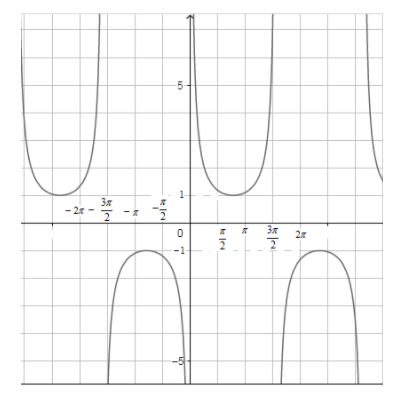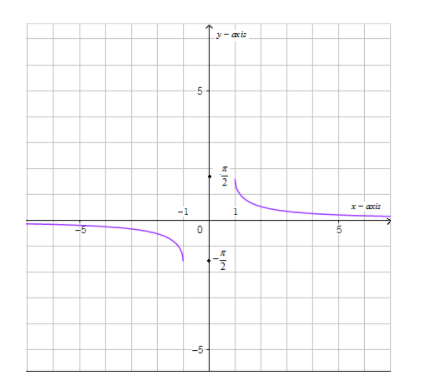
Determine the domain and range of
Answer
501k+ views
Hint: We will be using the concept of inverse trigonometric functions to solve the problem. We will be using the fact that the functions that have inverses are one – one and onto. Also, we will use the graph of
Complete step-by-step answer:
Now, we have to find the domain and range of
We know that a function that has an inverse has exactly one output for exactly one input. To keep inverse trigonometric functions consistent with this definition. We have to designate ranges for them that will take care of all the possible input values and don’t have any duplication.
Now, we have the graph of

Now, we can see that the function
Now, we know that the domain of an inverse trigonometric function is the same as that of the range of its counter trigonometric function.
Now, we know that the range of

So, we have the range of
Note: To solve these types of questions it is important to note that we have used a fact that the range of a function is equal to the domain of its inverse. Also it is important to know that a function is one-one when for each element in the range there is exactly one element in the domain and a function is onto when for every element of the range there is at least one element in the domain. Also the domain of function is equal to the range of its inverse and the inverse of a function exists, if the function is one – one and onto.
Complete step-by-step answer:
Now, we have to find the domain and range of
We know that a function that has an inverse has exactly one output for exactly one input. To keep inverse trigonometric functions consistent with this definition. We have to designate ranges for them that will take care of all the possible input values and don’t have any duplication.
Now, we have the graph of

Now, we can see that the function
Now, we know that the domain of an inverse trigonometric function is the same as that of the range of its counter trigonometric function.
Now, we know that the range of

So, we have the range of
Note: To solve these types of questions it is important to note that we have used a fact that the range of a function is equal to the domain of its inverse. Also it is important to know that a function is one-one when for each element in the range there is exactly one element in the domain and a function is onto when for every element of the range there is at least one element in the domain. Also the domain of function is equal to the range of its inverse and the inverse of a function exists, if the function is one – one and onto.
Latest Vedantu courses for you
Grade 10 | CBSE | SCHOOL | English
Vedantu 10 CBSE Pro Course - (2025-26)
School Full course for CBSE students
₹37,300 per year
Recently Updated Pages
Master Class 4 Maths: Engaging Questions & Answers for Success

Master Class 4 English: Engaging Questions & Answers for Success

Master Class 4 Science: Engaging Questions & Answers for Success

Class 4 Question and Answer - Your Ultimate Solutions Guide

Master Class 11 Economics: Engaging Questions & Answers for Success

Master Class 11 Business Studies: Engaging Questions & Answers for Success

Trending doubts
Give 10 examples of unisexual and bisexual flowers

Draw a labelled sketch of the human eye class 12 physics CBSE

Differentiate between homogeneous and heterogeneous class 12 chemistry CBSE

a Tabulate the differences in the characteristics of class 12 chemistry CBSE

Why is the cell called the structural and functional class 12 biology CBSE

Differentiate between insitu conservation and exsitu class 12 biology CBSE




